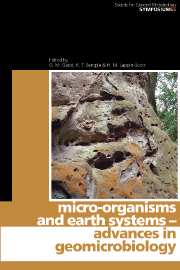Book contents
- Frontmatter
- Contents
- Contributors
- Editors' Preface
- Isotopic-labelling methods for deciphering the function of uncultured micro-organisms
- Biofilms and metal geochemistry: the relevance of micro-organism-induced geochemical transformations
- Minerals, mats, pearls and veils: themes and variations in giant sulfur bacteria
- Soil micro-organisms in Antarctic dry valleys: resource supply and utilization
- New insights into bacterial cell-wall structure and physico-chemistry: implications for interactions with metal ions and minerals
- Horizontal gene transfer of metal homeostasis genes and its role in microbial communities of the deep terrestrial subsurface
- Biosilicification: the role of cyanobacteria in silica sinter deposition
- Metabolic diversity in the microbial world: relevance to exobiology
- Biogeochemical cycling in polar, temperate and tropical coastal zones: similarities and differences
- Fungal roles and function in rock, mineral and soil transformations
- The deep intraterrestrial biosphere
- Iron, nitrogen, phosphorus and zinc cycling and consequences for primary productivity in the oceans
- Mechanisms and environmental impact of microbial metal reduction
- New insights into the physiology and regulation of the anaerobic oxidation of methane
- Biogeochemical roles of fungi in marine and estuarine habitats
- Role of micro-organisms in karstification
- Index
New insights into the physiology and regulation of the anaerobic oxidation of methane
Published online by Cambridge University Press: 06 July 2010
- Frontmatter
- Contents
- Contributors
- Editors' Preface
- Isotopic-labelling methods for deciphering the function of uncultured micro-organisms
- Biofilms and metal geochemistry: the relevance of micro-organism-induced geochemical transformations
- Minerals, mats, pearls and veils: themes and variations in giant sulfur bacteria
- Soil micro-organisms in Antarctic dry valleys: resource supply and utilization
- New insights into bacterial cell-wall structure and physico-chemistry: implications for interactions with metal ions and minerals
- Horizontal gene transfer of metal homeostasis genes and its role in microbial communities of the deep terrestrial subsurface
- Biosilicification: the role of cyanobacteria in silica sinter deposition
- Metabolic diversity in the microbial world: relevance to exobiology
- Biogeochemical cycling in polar, temperate and tropical coastal zones: similarities and differences
- Fungal roles and function in rock, mineral and soil transformations
- The deep intraterrestrial biosphere
- Iron, nitrogen, phosphorus and zinc cycling and consequences for primary productivity in the oceans
- Mechanisms and environmental impact of microbial metal reduction
- New insights into the physiology and regulation of the anaerobic oxidation of methane
- Biogeochemical roles of fungi in marine and estuarine habitats
- Role of micro-organisms in karstification
- Index
Summary
INTRODUCTION
Methane is an important link within the global carbon cycle and has become a major focus for scientific investigations over the last decades, especially since the discovery of large deposits of methane hydrates in continental margins. The majority of recent methane production is biogenic, i.e. produced either by thermogenic transformation of organic material or by methanogenesis as the final step in fermentation of organic matter carried out by methanogenic archaea in anoxic habitats (Reeburgh, 1996). There are also abiotic sources of methane, e.g. at mid-oceanic ridges, where serpentinization takes place. In marine environments, the bulk of the methane is produced in shelf and upper continental-margin sediments, which receive large amounts of organic matter from deposition (Reeburgh, 1996). As methane builds up, it migrates upwards and may reach the sediment surface. Here, its ebullition and oxidation can lead to the formation of complex geostructures, such as pockmarks or carbonate chimneys and platforms, as well as large-scale topographies, such as mud volcanoes and carbonate mounds (Ivanov et al., 1991; Milkov, 2000). In most of the deeper continental margin and the abyssal plain sediments, methane production is low, as only 1-5 % of the surface primary production reaches the bathyal and abyssal seabed, due to degradation processes in the water column (Gage & Tyler, 1996).
- Type
- Chapter
- Information
- Micro-organisms and Earth Systems , pp. 303 - 320Publisher: Cambridge University PressPrint publication year: 2005
- 2
- Cited by

